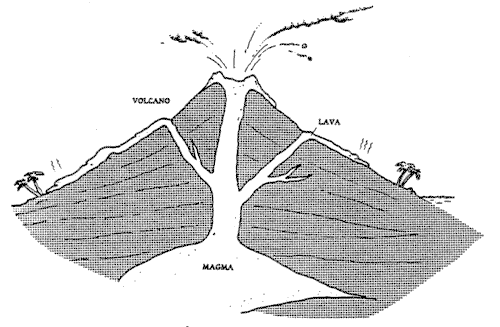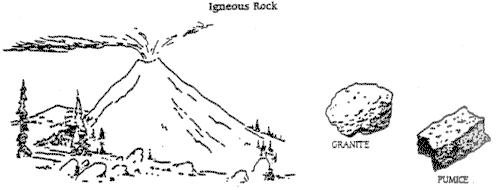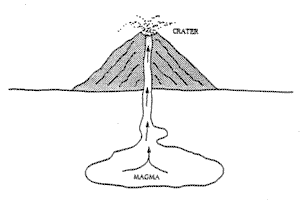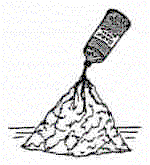
Return To Primary Lesson Plans
Click here for a printable version
Title: Igneous Rocks/Volcanoes
Level: Upper Primary
Time: 2-3 days
KERA Goals: 2.4, 2.5, 2.6
Materials: Rocks, balloon, water
Objective:
Students will differentiate between the two types of igneous rock and designate the area the rock comes from.
Background Information:
Igneous rocks are formed by the cooling of magma and lava.

Definitions:
extrusive - rocks cooled above earth's surface (lava).
Common Intrusive Rocks-- Granite, Quartz monzonite, Diorite
intrusive - rocks cooled below earth's surface (magma).
Common Extrusive Rocks-- Basalt, Pumice, Obsidian, Rhyolite
Activity:
Identify different types of igneous rocks from rock samples. Locate on diagram (above) the area where each rock can be found.
Fill balloon half full with water. Tie off. This will simulate how flowing lava feels.

Materials:
Activity: Make Your Own Volcano
Mix the plaster and water in a mixing pan.
Pour the plaster into the cone shaped cup.
Before the plaster hardens, turn the paper cup over and place it on a piece of paper.
Cut a small piece of the top off the cone.
Using your finger, or a pencil, push into the top of the plaster to form a crater. Be certain to hold the crater open until the plaster hardens.
Peel the paper cup off after plaster hardens.
Pour baking soda into the crater and add 2 or 3 drops of vinegar and watch it erupt.

Have students paint and decorate their volcanoes. Make tropical islands.

Materials:
Activity: Creeping Lava
Mold the aluminum foil into the shape of a volcano. Put in lots of creases to form valleys and ridges.
Put your volcano on a spread-out piece of newspaper.
What paths would lava take if it flowed down your volcano?
Pour the dark corn syrup on the very top of your volcano. Watch the "lava flow." Be certain to stop as soon as the syrup reaches the bottom.
Discussion:
Does the lava take the paths predicted?
Describe how the lava flows.
Where would you build your house to protect it from lava flows?
Let the syrup dry for half an hour. Then tip the volcano at an angle.
Does the syrup flow?
Poke the syrup with a pencil. Does it have a skin?
How is the syrup like real lava?
Return To Primary Lesson Plans
Provided by The Society for Mining, Metallurgy, and Exploration, Inc.